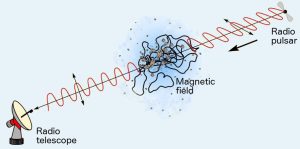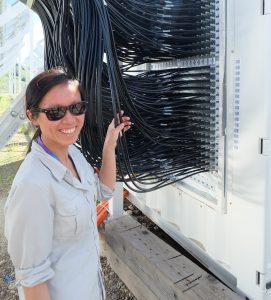Astronomers from the Dunlap Institute for Astronomy & Astrophysics have led a research team that has helped map the north-sky portion of the Milky Way Galaxy’s magnetic field.
The team used data from the CHIME telescope to measure the way in which invisible magnetism distorts the radio signals from rapidly spinning stars known as “pulsars.” The magnetism of the northern-sky portion of our Galaxy has previously been under-explored, since many of the world’s powerful radio telescopes are located in the southern hemisphere.
That’s why CHIME’s northern location was key to accessing this data – and so was its non-traditional cylinder design, which allowed the research team to study the signals from 10 different pulsars at any given time. “I was excited by the diverse potential of CHIME to perform this cutting-edge science,” explains Cherry Ng, Dunlap Institute postdoctoral researcher. “CHIME is really helping to complete the big picture of the Milky Way.”
Ng, along with University of Toronto undergraduate student Ayush Pandhi, are the lead authors of a publication that reports their team’s 80 new measurements of Galactic magnetism using background pulsars. This is a 20 per cent increase in the number of measurements that previously existed in the Northern Hemisphere.
Ng says that using pulsars to understand the Milky Way’s magnetic field could have large-scale implications for astronomy. “This will shed light on important questions such as the origin of the Galactic magnetic field and how it influences the behaviour of stars and gas.”
She says that there’s a lot more to do once more data is collected. “The more pulsar signals we can measure, the more complete a picture we can paint of magnetism in the Universe.”
Associated publication:
C Ng, A Pandhi, A Naidu, E Fonseca, V M Kaspi, K W Masui, R Mckinven, A Renard, P Scholz, I H Stairs, S P Tendulkar, K Vanderlinde, Faraday rotation measures of Northern hemisphere pulsars using CHIME/Pulsar, Monthly Notices of the Royal Astronomical Society, Volume 496, Issue 3, August 2020, Pages 2836–2848, https://doi.org/10.1093/mnras/staa1658
For more information, please contact:
Meaghan MacSween
Communications and Multimedia Officer
Dunlap Institute for Astronomy and Astrophysics,
University of Toronto
meaghan.macsween@dunlap.utoronto.ca
The Dunlap Institute for Astronomy & Astrophysics at the University of Toronto is an endowed research institute with more than 70 faculty, postdocs, students and staff, dedicated to innovative technology, ground-breaking research, world-class training, and public engagement. The research themes of its faculty and Dunlap Fellows span the Universe and include: optical, infrared and radio instrumentation; Dark Energy; large-scale structure; the Cosmic Microwave Background; the interstellar medium; galaxy evolution; cosmic magnetism; and time-domain science. The Dunlap Institute for Astronomy and Astrophysics, David A. Department of Astronomy & Astrophysics and the Canadian Institute for Theoretical Astrophysics comprise the leading centre for astronomical research in Canada, at the leading research university in the country, the University of Toronto.


